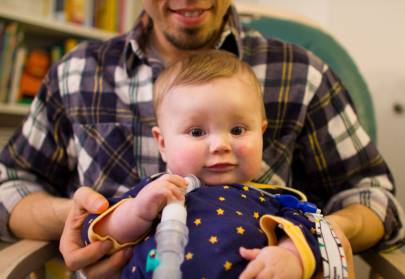Breathing Risks & Care
Breathing problems are the most common cause of illness for adults and children with spinal muscular atrophy (SMA).
Quick Links
Breathing Risks
In healthy individuals, the muscles between the ribs—called intercostal muscles—allow the chest to expand and fill the lungs with air. The diaphragm pulls the rib cage down, allowing the lungs to expand further. Individuals with spinal muscular atrophy (SMA) may have very weak intercostal muscles, which compromises this normal breathing rhythm. This can result in:
- Weak respiratory muscles and underdeveloped lungs
- A weak cough
- Severe risk of decreased respiratory muscle strength during viral respiratory infections—even infections that only cause minor illness for healthy individuals
- Increased risk of pneumonia
- Aspiration of food or drink
- Hypoventilation, or shallow breathing, especially during sleep

Breathing Care
It is important to visit a pulmonologist (a doctor who specializes in respiratory care) soon after an SMA diagnosis. The pulmonologist will evaluate you or your child, establish a baseline for future testing, and create a proactive plan. This plan may include:
-
- A schedule for continued assessment and monitoring. Children and adults with SMA Types 1 (non-sitter) or Type 2 (sitter) may need to be seen by a pulmonologist every three to six months, even if everything seems normal. Individuals with SMA Type 3 (walker) may have less frequent visits
- Ways to assist with coughing, airway clearance, and removal of mucus and other secretions
- Assessing sleep and the need for breathing support, also called ventilation (see information box to right)
- A system to measure and maintain oxygen levels in the blood
- Guidelines for care during certain situations, including illness and preparation for (or recovery from) surgery
- Vaccinations including influenza, COVID, and pneumococcus
What is Ventilation?
The choice of breathing support can be invasive or non-invasive. This can be a complicated and difficult decision.
- Non-invasive ventilation is breathing support delivered through a mask over the nose, or nose and mouth. BiPAP (see below) is a common form of non-invasive ventilation
- Invasive ventilation is breathing support delivered through a tube that goes inside the body. An endotracheal tube, which is inserted through the mouth, is one form of invasive ventilation. For long-term invasive ventilation, a tracheostomy tube is usually required. During a surgical procedure, the doctor makes a small incision in the individual’s neck and inserts the tube directly into the trachea
Many individuals with SMA manage with non-invasive ventilation. They may use breathing support only during sleep or illness, or more often.
Individuals with SMA Type 1(non-sitter) may need greater assistance with breathing. These decisions are made based on the individual’s needs and on the course of care chosen. Parents should openly discuss their options with their doctor, as soon as possible after diagnosis.
Breathing Equipment
Individuals with SMA often require a range of specialized medical equipment. This equipment can be used to aid in breathing, coughing, and swallowing. The following is a list of equipment that has proven beneficial for many people with SMA.
Note: This is not a comprehensive list and is not a substitute for professional, personalized advisement from a physician or other healthcare provider. Be sure to speak with your healthcare provider—and, in many cases, your insurance company—before making any decisions on medical equipment.


